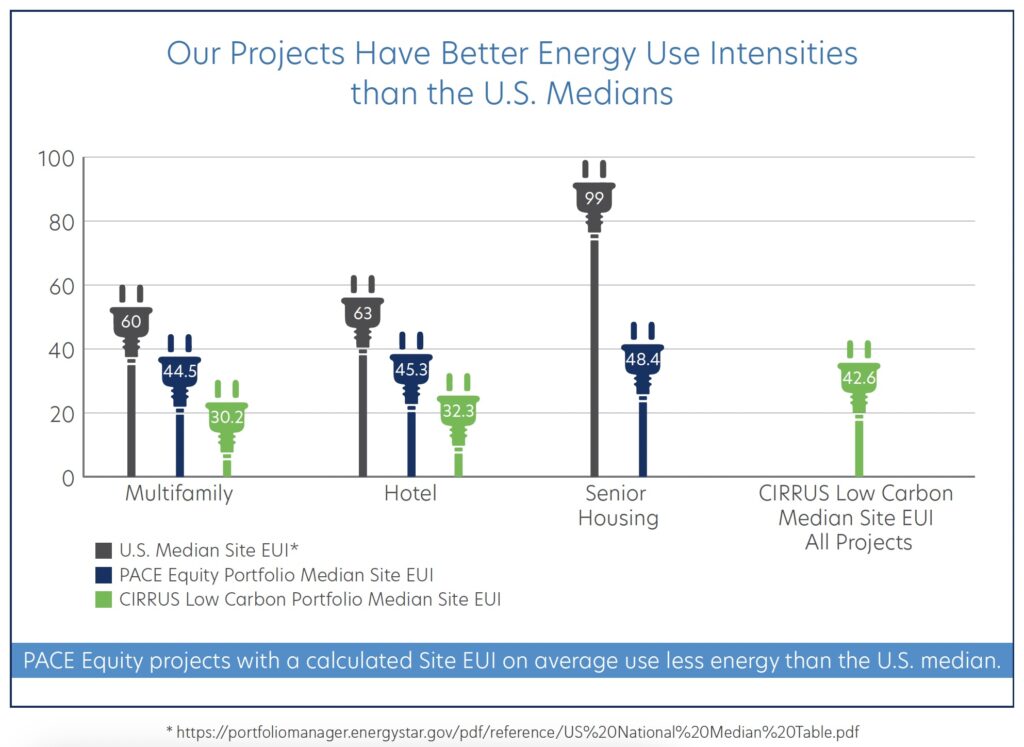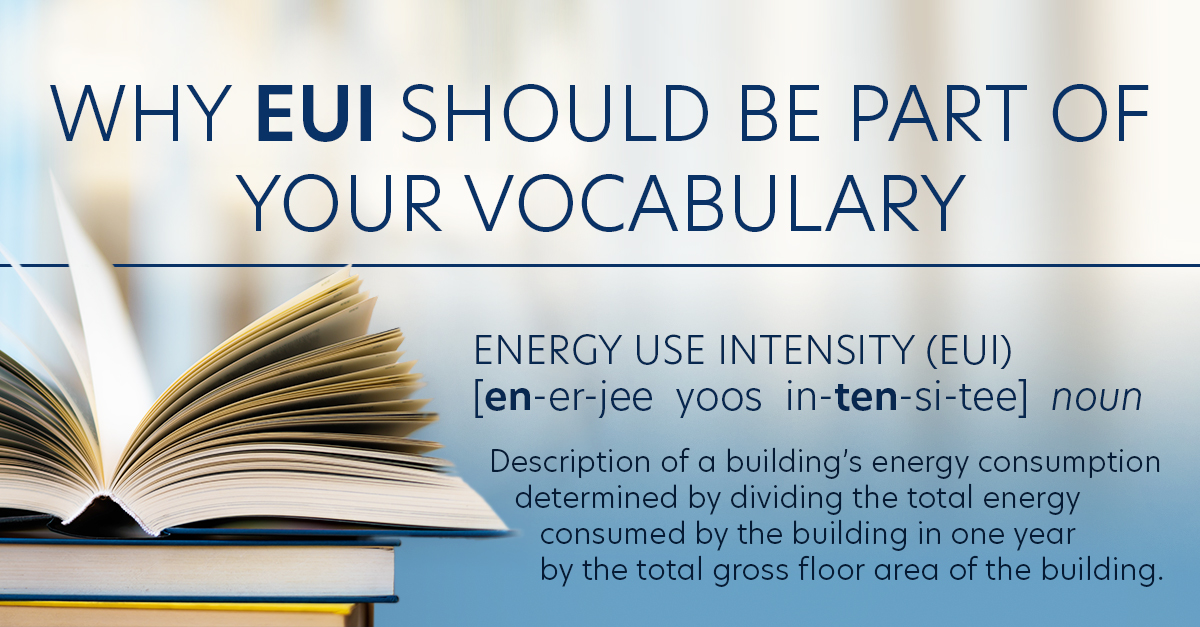Energy Use Intensity (EUI) is a common metric being used to define a building’s energy efficiency, as well as a factor when assessing its riskiness as an investment. EUI measures a facility’s energy performance on a per square foot basis. It’s calculated by dividing the total amount of energy a building consumes in a year by its total gross floor area. The EPA manages a database of buildings broken down by type and size of building, giving you a frame of reference to compare your energy efficiency results with others.
When calculating EUI, rather than measuring energy in kilowatt hours (kWh) of electricity or therms of natural gas, it’s converted to a common unit of measurement, such as British thermal units (BTU) or gigajoules (GJ). The most common formula for calculating EUI is kBtu/square foot/year.
Energy Use Intensity (EUI) = Thousands of British Thermal Units Used Per Square Foot per Year (kBtu/sq. ft./year)
Site EUI vs. Source EUI
The EUI of a building can be broken down even more by understanding the terms “Site EUI” and “Source EUI”. Both terms refer to the energy intensity of the building, however the term Site EUI refers to the building and its energy intensity and carbon emissions as a stand-alone entity.
It is widely believed that a more accurate method to define and share the efficiency of a building, as well as its carbon emissions, is to consider how the energy it consumes is generated. This is referred to as a building’s Source EUI. Source EUI refers to the energy intensity of the building along with the source of the energy for the building – where and how the local utility company generates electricity. If a utility uses coal or other fossil-fuel burning technologies, this negatively affects the Source EUI of the buildings using that energy. Conversely, if the utility uses solar or wind as a portion of its generation capability, the Source EUI is improved. Source EUI takes into account both how the energy for the building is generated (coal vs. wind, for example) as well as the energy lost during production, storage, transmission, and delivery to the site which is often a result of the distance of the building from the location where the energy is generated. Source EUI is calculated using eGrid charts available from the EPA at https://www.epa.gov/egrid/power-profiler#/ which has calculators for Source EUI based on the profile of energy generation using a building’s location.
What’s the Difference between EUI and Energy Efficiency?
Energy Use Intensity and Energy Efficiency are often used interchangeably. Energy Use Intensity is calculated for a building in aggregate – looking at all building energy consumption and measuring it in reference to the size and use of the building. Energy Efficiency is most often defined by the efficiency of the products in the building design. Product efficiency is defined by a variety of industry metrics; HVAC equipment efficiency is defined by SEER, SEER2, HSPF, HSPF2, COP, and other metrics. Water heating equipment efficiency is defined by its UEF or EF data. Buildings are referred to as “energy efficient” when the building owner makes strong design choices for a new construction project or a renovation project that include efficient HVAC and water heating equipment, airtight envelope choices, efficient water-consuming devices, LED lighting and controls, and occupancy and use-based controls and building technology.
Efficient Properties are Less Risky Investments
Using building energy simulations, researchers at the Lawrence Berkeley National Laboratory found building asset characteristics and operational practices that affect Source EUI have very important effects on the likelihood of default. In general, the lower the EUI (the less energy usage per square foot), the lower the likelihood of default. A lower Source EUI can lead to a more favorable loan assessment by lenders, as it indicates a property with lower energy costs and improved net operating income. This can potentially result in better loan terms such as lower interest rates or higher loan amounts.
Start Getting Rewarded Today
Programs like PACE Equity’s CIRRUS financing directly rewards you with lower financing rates when you build a better building with a lower EUI. Pursuing a program like CIRRUS will also help you position your property favorably across your capital stack. The CIRRUS program delivers C-PACE financing PLUS a green building certification. CIRRUS requires a building design or renovation plan where the energy efficiency exceeds the best building code in the country by 5%. Supported by our Design Guidance team (at no additional cost), you can build a high-performance building and get rewarded for doing so.
-
- Lower financing rate from PACE Equity
-
- Lower energy costs
-
- Higher property value
-
- Reduced risk profile
PACE Equity Projects have Better EUIs than the U.S. Medians by Asset Class
Whether you are using standard C-PACE financing from PACE Equity or our CIRRUS financing option, energy efficiency is a core tenet of the construction and renovation projects we fund. Get the details about how C-PACE financing works and see how your project is eligible for our low cost, fixed rate, non-recourse, long-term financing.

Get started on financing your next energy efficient project by scheduling a meeting with a local Managing Director at www.pace-equity.com/schedule-a-meeting.
Learn more about Building Performance Standards and their EUI requirements by downloading our white paper on A Developer Strategy for Funding Building Performance Standards.






